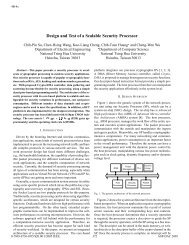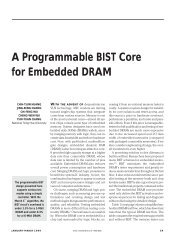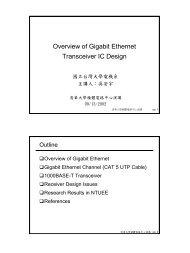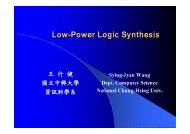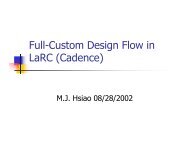A robust feedforward compensation scheme for multistage ...
A robust feedforward compensation scheme for multistage ...
A robust feedforward compensation scheme for multistage ...
You also want an ePaper? Increase the reach of your titles
YUMPU automatically turns print PDFs into web optimized ePapers that Google loves.
240 IEEE JOURNAL OF SOLID-STATE CIRCUITS, VOL. 38, NO. 2, FEBRUARY 2003<br />
its effects can be neglected. For the sake of simplicity, other<br />
parasitic poles are not considered. If , the closed-loop<br />
amplifier pulse response can be obtained from (5) as<br />
(9)<br />
Low-frequency pole–zero pair degrades the settling-time per<strong>for</strong>mance<br />
and the slow-settling components can be avoided if<br />
the cancellation occurs at high frequencies. If and are not<br />
close to each other, dominates the speed of the system. For<br />
0.1% accuracy in the final value, a settling time of around s<br />
is required. If is around , then a settling time of around<br />
s is enough. Notice in (9) that the slowest component is<br />
associated with the closed-loop dominant pole , there<strong>for</strong>e it<br />
is important to match the frequency of the zero with this pole in<br />
order to minimize the settling time. If the amplifier is designed<br />
such that<br />
, the zero<br />
and poles are approximately located at the following frequencies:<br />
(10)<br />
Fig. 6.<br />
Single-ended amplifier with NCFF <strong>compensation</strong> <strong>scheme</strong>.<br />
TABLE I<br />
TRANSISTOR DIMENSIONS AND BIAS CURRENTS<br />
(11)<br />
(12)<br />
This condition guarantees that and are close to each<br />
other, regardless of the absolute value of capacitors used. This<br />
condition is illustrated in Fig. 4(b). It is worth mentioning<br />
that reducing the parasitic capacitors at the output of the first<br />
stage increases the frequency of both and and<br />
the pole–zero cancellation occurs at high frequencies. If the<br />
zero cancels the dominant pole, the speed of the amplifier<br />
is determined by the highest frequency pole— . Typical<br />
process parameter variations and different load conditions are<br />
such that the pole locations can change by a factor of two<br />
or three, but the mismatch between the dominant pole and<br />
the zero is much less than that, especially if the condition<br />
is satisfied. Another<br />
important point to be noted is that complex poles may appear<br />
<strong>for</strong> large load capacitors .<br />
IV. CIRCUIT REALIZATION<br />
The two-stage amplifier using the NCFF <strong>compensation</strong><br />
<strong>scheme</strong> has the following design considerations.<br />
1) The second and <strong>feed<strong>for</strong>ward</strong> stage should not have any<br />
nondominant pole be<strong>for</strong>e the overall .<br />
2) The pole–zero cancellation should occur at high frequencies<br />
<strong>for</strong> best settling-time per<strong>for</strong>mance.<br />
3) The overall amplifier’s dc gain should be high.<br />
These conditions can be met if the stages are chosen as<br />
follows. The first stage can be designed to have a high gain<br />
and small load capacitance. The second and <strong>feed<strong>for</strong>ward</strong> stages<br />
should be optimized <strong>for</strong> high bandwidth and medium gain per<strong>for</strong>mance.<br />
The schematic of the single-ended amplifier using<br />
the NCFF <strong>compensation</strong> <strong>scheme</strong> is shown in Fig. 6. The first<br />
stage (M1, M4, M5, M6) is a telescopic amplifier with high dc<br />
gain. The second (M2, M7) and <strong>feed<strong>for</strong>ward</strong> stages (M3, M7)<br />
are single-ended differential amplifiers. Equations (13)–(17)<br />
show the dc gain of the three stages, internal capacitor (load<br />
capacitor of first stage), and output conductance.<br />
(13)<br />
(14)<br />
(15)<br />
(16)<br />
(17)<br />
The design strategy is to place the LHP zero and the closed-loop<br />
dominant pole, which are given by (10) and (11), at the same<br />
frequency. The bias currents and aspect ratios of the second<br />
and <strong>feed<strong>for</strong>ward</strong> stage are adjusted such that<br />
. The transistor dimensions and bias currents are given<br />
in Table I. The amplifier was designed in AMI 0.5- m technology<br />
with a power supply of 1.25 V. Power-supply voltages<br />
of 0–2.5 V can also be used if the proper common-mode





